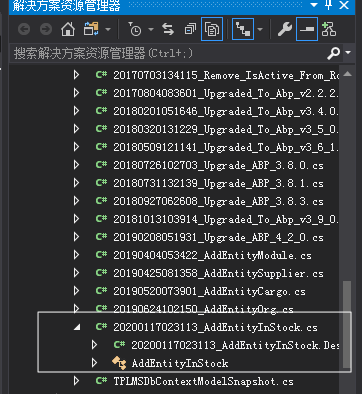通過前面的文章的學習,我們已經有實現了使用ABP提供的WebAPI方式+EasyUI來實現增刪改查的功能。之前我們把一些基本的信息已經完成了,如貨物信息,供應商信息。有了前面的基礎信息,我們可以實現入庫管理功能。從本章開始我們來學習一個入庫單功能,這個將會涉及DataGrid的主從功能。 一... ...
abp(net core)+easyui+efcore實現倉儲管理系統目錄
abp(net core)+easyui+efcore實現倉儲管理系統——ABP總體介紹(一) abp(net core)+easyui+efcore實現倉儲管理系統——解決方案介紹(二) abp(net core)+easyui+efcore實現倉儲管理系統——領域層創建實體(三) abp(net core)+easyui+efcore實現倉儲管理系統——定義倉儲並實現 (四) abp(net core)+easyui+efcore實現倉儲管理系統——創建應用服務(五) abp(net core)+easyui+efcore實現倉儲管理系統——展現層實現增刪改查之控制器(六) abp(net core)+easyui+efcore實現倉儲管理系統——展現層實現增刪改查之列表視圖(七) abp(net core)+easyui+efcore實現倉儲管理系統——展現層實現增刪改查之增刪改視圖(八) abp(net core)+easyui+efcore實現倉儲管理系統——展現層實現增刪改查之菜單與測試(九) abp(net core)+easyui+efcore實現倉儲管理系統——多語言(十) abp(net core)+easyui+efcore實現倉儲管理系統——使用 WEBAPI實現CURD (十一) abp(net core)+easyui+efcore實現倉儲管理系統——菜單-上 (十六)abp(net core)+easyui+efcore實現倉儲管理系統——EasyUI前端頁面框架 (十八)
abp(net core)+easyui+efcore實現倉儲管理系統——EasyUI之貨物管理一 (十九) abp(net core)+easyui+efcore實現倉儲管理系統——EasyUI之貨物管理八(二十六) abp(net core)+easyui+efcore實現倉儲管理系統——ABP WebAPI與EasyUI結合增刪改查之一(二十七) abp(net core)+easyui+efcore實現倉儲管理系統——ABP WebAPI與EasyUI結合增刪改查之三(二十九) abp(net core)+easyui+efcore實現倉儲管理系統——ABP WebAPI與EasyUI結合增刪改查之四(三十)abp(net core)+easyui+efcore實現倉儲管理系統——ABP WebAPI與EasyUI結合增刪改查之八(三十四)
abp(net core)+easyui+efcore實現倉儲管理系統——ABP WebAPI與EasyUI結合增刪改查之十(三十六)一.前言
通過前面的文章( abp(net core)+easyui+efcore實現倉儲管理系統——ABP WebAPI與EasyUI結合增刪改查之一(二十七) 至abp(net core)+easyui+efcore實現倉儲管理系統——ABP WebAPI與EasyUI結合增刪改查之十(三十六) )的學習,我們已經有實現了使用ABP提供的WebAPI方式+EasyUI來實現增刪改查的功能。之前我們把一些基本的信息已經完成了,如貨物信息,供應商信息。有了前面的基礎信息,我們可以實現入庫管理功能。從本章開始我們來學習一個入庫單功能,這個將會涉及DataGrid的主從功能。
二、入庫單的流程
1.一般情況下會有一個前置的OMS系統——即訂單管理系統。主要功能之一是由供應商填寫送貨單。
如果公司有貨代、倉儲、運輸等業務,或者是給某些大型客戶(例如宜家、聯想等)做第三方的物流服務,那麼在做物流系統時入庫單流程時,需要考慮入庫單的前置流程——訂單管理系統。
訂單管理系統(OMS)是物流信息管理系統的一部分,通過對客戶下達的訂單進行管理及跟蹤,動態掌握訂單的進展和完成情況,提升物流過程中的作業效率,從而節省運作時間和作業成本,提高物流企業的市場競爭力。顧名思義,訂單管理系統是物流企業用戶、供應商用戶、客戶對於訂單的管控、跟蹤的系統,銜接著WMS、運輸管理系統、訂艙系統等,是物流信息管理系統的基礎模塊。
簡單地說訂單管理系統作為整個物流信息管理系統的基礎核心,管理著所有的交易進出。一個好的訂單管理系統需要有很好地擴展性和流暢性,在一個物流信息管理系統從0-1的過程,訂單管理系統作為其基礎模塊需要提前考慮到各系統的擴展,訂單管理系統如果在前期就能考慮到後面的擴展,相信對於物流企業的壯大會非常有幫助。
流暢性指的是整個交易鏈路需要很流暢,早期公司做訂單系統時,想的很複雜,想做的很全面,最後做的非常龐大,但是卻沒有考慮到整個物流流程的通暢性,導致連基礎的訂單流程都沒有辦法正常走下去,所以,在從0到1地做一套訂單管理系統時,需要有一些前瞻性,但落地時,需要先實現一個可以把整個流程走下去的簡單的訂單管理系統,然後不斷的去試錯->改進。
2.當運輸公司把貨物送到倉庫時,倉庫會有檢驗員進行抽檢,並製作入庫單,分配庫位,然後列印標簽,粘貼條碼標簽,分配托盤,核驗條碼標簽,貨物上架,併在系統中對入庫單進行審核通過。整個流程如下圖。

當然我們接下來要實現的入庫單功能,沒有這麼複雜。 我們沒有實現訂單管理系統,這個有時間後面補上。
三、創建入庫單實體
1. 做為一個入庫單,在資料庫中一般存在三張表,表頭InStockOrder,表體InStockDetail、庫位表InStockDetailLoc。
2.在Visual Studio 2017的“解決方案資源管理器”中,右鍵單擊“ABP.TPLMS.Core”項目的“Entitys”文件夾,在彈出菜單中選擇“添加” >
> “類”。 將類命名為 InStockOrder,然後選擇“添加”。
3.創建InStockOrder類繼承自Entity<int>,通過實現審計模塊中的IHasCreationTime來實現保存創建時間。代碼如下:
using Abp.Domain.Entities; using Abp.Domain.Entities.Auditing; using System; using System.Collections.Generic; using System.ComponentModel.DataAnnotations; using System.ComponentModel.DataAnnotations.Schema; using System.Text; namespace ABP.TPLMS.Entitys { public class InStockOrder : Entity<int>, IHasCreationTime { public const int MaxLength = 255; public InStockOrder() { No = string.Empty; CustomerCode = string.Empty; CustomerName = string.Empty; WarehouseNo = string.Empty; WarehouseType = string.Empty; DeliveryNo = string.Empty; Receiver = string.Empty; ReceiveTime = string.Empty; CreationTime = DateTime.Now; Oper = string.Empty; Checker = string.Empty; CheckTime = string.Empty; Gwt = 0; Nwt = 0; PackageNum = 0; OwnerCode = string.Empty; OwnerName = string.Empty; Remark = string.Empty; Status = 0; PreDeliveryTime = string.Empty; } [StringLength(50)] [Required] public string No { get; set; } /// <summary> /// 客戶名稱 /// </summary> [StringLength(MaxLength)] [Required] public string CustomerName { get; set; } public string WarehouseType { get; set; } /// <summary> /// 客戶代碼 /// </summary> [StringLength(50)] [Required] public string CustomerCode { get; set; } /// <summary> /// 送貨單號 /// </summary> public string DeliveryNo { get; set; } /// <summary> /// 倉庫號 /// </summary> public string WarehouseNo { get; set; } /// <summary> /// 貨主 /// </summary> [StringLength(MaxLength)] [Required] public string OwnerName { get; set; } public decimal Gwt { get; set; } public decimal Nwt { get; set; } public int PackageNum { get; set; } /// <summary> /// 接收時間 /// </summary> [StringLength(20)] public string ReceiveTime { get; set; } /// <summary> /// 接收人 /// </summary> [StringLength(50)] public string Receiver { get; set; } [StringLength(50)] public string Oper { get; set; } public int Status { get; set; } [StringLength(50)] public string OwnerCode { get; set; } /// <summary> /// 預計送貨時間 /// </summary> [StringLength(20)] public string PreDeliveryTime { get; set; } /// <summary> /// 審核人 /// </summary> [StringLength(50)] public string Checker { get; set; } [StringLength(20)] public string CheckTime { get; set; } [StringLength(1000)] public string Remark { get; set; } public DateTime CreationTime { get; set; } [StringLength(20)] public string LastUpdateTime { get; set; } [StringLength(50)] public string LastOper { get; set; } [NotMapped] public List<InStockOrderDetail> InStockOrderDetail { get; set; } } }
4.重得第2,3步,我們在“ABP.TPLMS.Core”項目的“Entitys”文件夾,依次創建InStockOrderDetail與InStockOrderDetailLoc兩個類。代碼如下:
using Abp.Domain.Entities; using Abp.Domain.Entities.Auditing; using System; using System.Collections.Generic; using System.ComponentModel.DataAnnotations; using System.ComponentModel.DataAnnotations.Schema; using System.Text; namespace ABP.TPLMS.Entitys { public class InStockOrderDetail : Entity<int>, IHasCreationTime { public const int MaxLength = 255; public InStockOrderDetail() { this.Qty = 0; this.CargoCode = string.Empty; this.CargoName = string.Empty; this.Brand = string.Empty; this.Country = string.Empty; this.CreationTime = DateTime.Now; this.Curr = string.Empty; this.GrossWt = 0; this.Height = 0; this.HSCode = string.Empty; this.Length = 0; this.SecdLawfQty = 0; this.LawfQty = 0; this.NetWt = 0; this.Package = string.Empty; this.Price = 0; this.Spcf = string.Empty; this.Unit = string.Empty; this.InStockNo = string.Empty; this.LawfUnit = string.Empty; this.Vol = 0; this.Width = 0; this.LawfUnit = string.Empty; this.SecdLawfUnit = string.Empty; this.SeqNo = 0; this.Batch = string.Empty; this.DeliveryOrderDetailId = 0; } public int SupplierId { get; set; } [MaxLength(50)] public string CargoCode { get; set; } [MaxLength(10)] public string HSCode { get; set; } [MaxLength(MaxLength)] public string CargoName { get; set; } [MaxLength(MaxLength)] public string Spcf { get; set; } [MaxLength(20)] public string Unit { get; set; } [MaxLength(20)] public string Country { get; set; } [MaxLength(50)] public string Brand { get; set; } [MaxLength(20)] public string Curr { get; set; } [MaxLength(20)] public string Package { get; set; } public decimal Length { get; set; } public decimal Width { get; set; } public decimal Height { get; set; } public decimal Vol { get; set; } public decimal Price { get; set; } public decimal TotalAmt { get; set; } public decimal GrossWt { get; set; } public decimal NetWt { get; set; } public DateTime CreationTime { get; set; } [MaxLength(20)] public string InStockNo { get; set; } public int SeqNo { get; set; } public decimal Qty { get; set; } public decimal LawfQty { get; set; } public decimal SecdLawfQty { get; set; } [MaxLength(20)] public string LawfUnit { get; set; } [MaxLength(20)] public string SecdLawfUnit { get; set; } [MaxLength(20)] public string Batch { get; set; } public int DeliveryOrderDetailId { get; set; } [NotMapped] public List<InStockOrderDetailLoc> InStockOrderDetailLoc { get; set; } } }
using Abp.Domain.Entities; using Abp.Domain.Entities.Auditing; using System; using System.Collections.Generic; using System.ComponentModel.DataAnnotations; using System.Text; namespace ABP.TPLMS.Entitys { public class InStockOrderDetailLoc : Entity<int>, IHasCreationTime { public InStockOrderDetailLoc() { this.Qty = 0; this.SeqNo = 0; this.Loc = string.Empty; this.CreationTime = DateTime.Now; this.InStockOrderDetailId = 0; } public int InStockOrderDetailId { get; set; } public int SeqNo { get; set; } [StringLength(50)] public string Loc { get; set; } public decimal Qty { get; set; } public DateTime CreationTime { get; set; } } }
5.定義入庫單的實體之後,我們去“ABP.TPLMS.EntityFrameworkCore”項目中的“TPLMSDbContext”類中定義實體對應的DbSet,以應用Code First 數據遷移。添加以下代碼
using Microsoft.EntityFrameworkCore; using Abp.Zero.EntityFrameworkCore; using ABP.TPLMS.Authorization.Roles; using ABP.TPLMS.Authorization.Users; using ABP.TPLMS.MultiTenancy; using ABP.TPLMS.Entitys; namespace ABP.TPLMS.EntityFrameworkCore { public class TPLMSDbContext : AbpZeroDbContext<Tenant, Role, User, TPLMSDbContext> { /* Define a DbSet for each entity of the application */ public TPLMSDbContext(DbContextOptions<TPLMSDbContext> options) : base(options) { } public DbSet<Module> Modules { get; set; } public DbSet<Supplier> Suppliers { get; set; } public DbSet<Cargo> Cargos { get; set; } public DbSet<Org> Orgs { get; set; } public virtual DbSet<InStockOrder> InStockOrder { get; set; } public virtual DbSet<InStockOrderDetail> InStockOrderDetail { get; set; } public virtual DbSet<InStockOrderDetailLoc> InStockOrderDetailLoc { get; set; } } }6.從菜單中選擇“工具->NuGet包管理器器—>程式包管理器控制台”菜單。
7. 在PMC中,預設項目選擇EntityframeworkCore對應的項目後。輸入以下命令:Add-Migration AddEntityInStock,創建遷移。如下圖。

8. 在上面的命令執行完畢之後,創建成功後,會在Migrations文件夾下創建時間_AddEntityInStock格式的類文件,這些代碼是基於DbContext指定的模型。如下圖。

9.在程式包管理器控制台,輸入Update-Database,回車執行遷移。執行成功後,如下圖。

10. 在SQL Server Management Studio中查看資料庫,InStockOrder、InStockOrderDetail、InStockOrderDetailLoc三張表創建成功。




